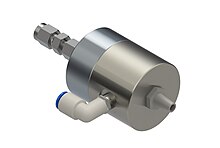
Ultrasonic nozzles are a type of spray nozzle that use high frequency vibrations produced by piezoelectric transducers acting upon the nozzle tip that create capillary waves in a liquid film. Once the amplitude of the capillary waves reaches a critical height (due to the power level supplied by the generator), they become too tall to support themselves and tiny droplets fall off the tip of each wave resulting in atomization.[1]
The primary factors influencing the initial droplet size produced are frequency of vibration, surface tension, and viscosity of the liquid. Frequencies are commonly in the range of 20–180 kHz, beyond the range of human hearing, where the highest frequencies produce the smallest drop size.[2]
- ^ Lang, Robert (1962). "Ultrasonic Atomization of Liquids". The Journal of the Acoustical Society of America. 34 (1): 6. Bibcode:1962ASAJ...34....6L. doi:10.1121/1.1909020.
- ^ Berger, Harvey (1998). Ultrasonic Liquid Atomization Theory and Application. Hyde Park, NY: Partridge Hill Publishers. p. 44. ISBN 978-0-9637801-5-7.
© MMXXIII Rich X Search. We shall prevail. All rights reserved. Rich X Search
